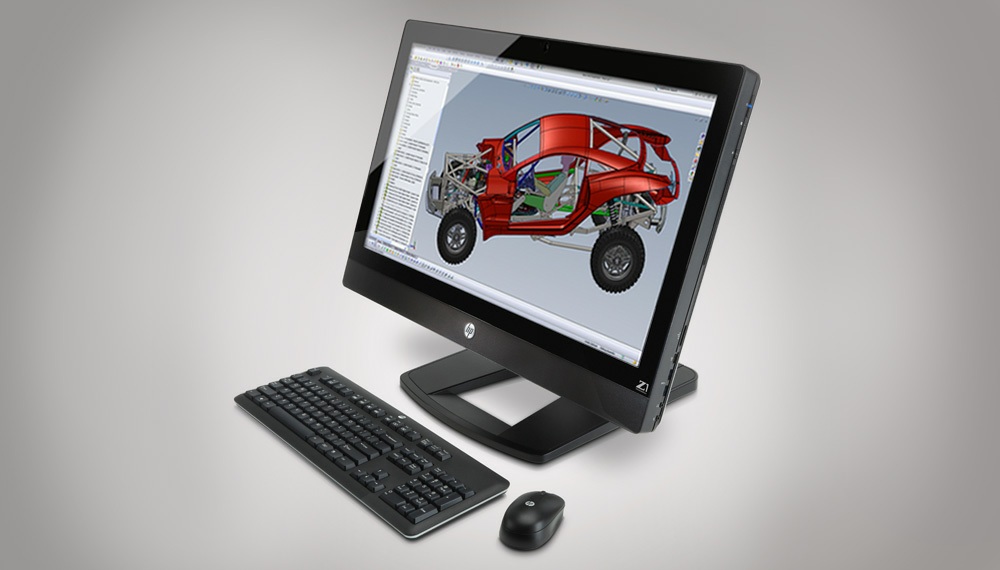HP Z1 Workstation review
This 27in All-in-One packs an Intel Ivy Bridge Xeon processor, 8GB of RAM and unprecedented access to the components. But is it worth the £2500 price?
HP should be commended for putting together the most impressive All-in-One we've ever seen. Those after pure power would still be better served by a traditional workstation, though, and the price means it's likely to be reserved for the wealthiest of IT departments.

Performance
The Z1 is available with a broad choice of components. Our review sample was configured with the best HP had to offer and it was a tasty specification. Grunt was provided by an Xeon E3-1280 processor, one of Intel's latest Ivy Bridge chips. It's based on a 22nm manufacturing process, and its four Hyper-Threaded cores can address eight concurrent tasks. The Xeon chip runs at 3.6GHz, and two of its cores can use Turbo Boost to reach a temporary maximum of 4GHz.
The processor is partnered with 8GB of RAM, and storage is provided by a 1TB Hitachi Deskstar SATA/600 drive. The Z1 scored 1.02 in our application benchmarks. This is better than machines such as the VeryPC Broadleaf, which scored just 0.66 with its Core i3 processor.
The hard disk provided excellent benchmark results, thanks in part to its SATA/600 interface. It wrote large files at 252.1MB/s, speed which nips at the heels of mainstream SSDs. Its large file read score of 120MB/s and small file write result of 101.7MB/s are both impressive, too, although the Z1's small file read score of 23.8MB/s is more the kind of speed we'd expect from a hard disk.

HP provides a choice between NVIDIA's graphics cards, but this will add considerably to the price
Graphical power was provided by NVIDIA's Quadro Q3000M graphics chip - one of the most powerful mobile parts produced by the chip maker. In the Z1, the card is supplanted onto a desktop-style card. It's clear this has the power required of high-end applications: a high-end Crysis benchmark score of 46fps is a good start, and this dropped to a still-impressive 39fps when we ran the test at the screen's native resolution of 2,560 x 1,440. That's on a par with Nvidia's consumer-level GeForce GTX 560, and should be enough power for graphically demanding business applications.
The mobile graphics chip means the Z1 can't compete with the most powerful workstations, but its 3,293 overall score in PCMark 7 is still up there, and a score of 1,738 in 3DMark 11's performance benchmark is able to compete with some of the most powerful mobile workstations. The Quadro handles 3DMark better than it did Crysis, too its score in this test is on par with the more powerful GTX 560 Ti 448.
Our final benchmarks regarding power and thermal performance, saw mixed results. The processor's peak temperature of 81 degrees was within the range expected, and the graphics card's top temperature of 45 degrees was low, but we noticed plenty of heat in certain places. The two areas of the screen nearest the processor heatsink and graphics cards got toasty, and plenty of heat was expelled through vents at the top of the chassis.
Get the ITPro daily newsletter
Sign up today and you will receive a free copy of our Future Focus 2025 report - the leading guidance on AI, cybersecurity and other IT challenges as per 700+ senior executives
Mike Jennings has worked as a technology journalist for more than a decade and has been fascinated by computers since childhood, when he spent far too long building terrible websites. He loves desktop PCs, components, laptops and anything to do with the latest hardware.
Mike worked as a staff writer at PC Pro magazine in London for seven years, and during that time wrote for a variety of other tech titles, including Custom PC, Micro Mart and Computer Shopper. Since 2013, he’s been a freelance tech writer, and writes regularly for titles like Wired, TechRadar, Stuff, TechSpot, IT Pro, TrustedReviews and TechAdvisor. He still loves tech and covers everything from the latest business hardware and software to high-end gaming gear, and you’ll find him on plenty of sites writing reviews, features and guides on a vast range of topics.
You can email Mike at mike@mike-jennings.net, or find him on Twitter at @mikejjennings
-
 Darktrace unveils tailored AI models with a twist for its cybersecurity agent
Darktrace unveils tailored AI models with a twist for its cybersecurity agentNews Darktrace has announced new AI models for its agentic AI security tool, but it's taken a novel approach to tackle hallucinations.
By Rory Bathgate Published
-
 This tech company wants to pay staff to look after their mental and physical wellbeing
This tech company wants to pay staff to look after their mental and physical wellbeingNews Hot on the heels of its four-day week trial, tech company Thrive is offering staff new incentives to take care of their mental and physical wellbeing.
By Ross Kelly Published
-
 Hacked law firm 'didn't think it was a data breach' – the ICO disagreed
Hacked law firm 'didn't think it was a data breach' – the ICO disagreedNews The ICO has fined DPP Law for failing to report an attack that saw confidential information released on the dark web
By Emma Woollacott Published